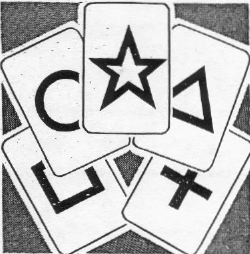
Scientists tend to have a skeptical view of ESP and parapsychology.There seems to be a lot of room for fraud when it comes to ESP. Because of this people are naturally skeptical. Does this mean that ESP and the researchers investigating this phenomenon arrant doing valid research? Surprisingly there is research indicating that there is something to ESP.
When most people think of parapsychologists researching ESP they automatically think of ESP testing cards. J.B Rhine who is some times refereed to the father of parapsychology created these cards. His career in parapsychology began at
ESP research was taken even further at the Maimonides medical center in
The most recent studies around ESP actually came from interestingly enough the
Remote viewing essentially is a scientific term for clairvoyance. It is defined as the ability of experienced or inexperienced to view, by means of mental processes, remote geographical or technical targets such as roads, buildings, and laboratory apparatus. (Targ and Puthoff ix) Put more simply it could be defined as the ability to perceive remote locations while not being there physically. Remote viewing experiments started in early 1970s at Stanford Research Institute.
Remote viewing first happened as sort of an accident. Shortly after getting the CIA contract Puthoff hired a man named Russell Targ. Like Puthoff Targ was also a laser physicist. Targ created an ESP training machine. The machine consisted of a computer that had light bulbs behind four slides. The computer would randomly light up a slide and the subject using this was to guess which slide would light up. Ingo Swann didn't like this machine. It reminded him of the earlier forced choice work in parapsychology. One day Swann suggested that Puthoff and Targ give him geological coordinates and he would describe what he saw. Puthoff and Targ didn't like this mainly because if Swann did get accurate information skeptics would ague that he had a photographic memory. Ingo would not let this go after threatening to quit Puthoff and Targ finally gave in. After trying this a few times they decided to do some more research in this area after Swann successfully described the coordinates. (Schnabel 98-104) This procedure evolved into the remote viewer or psychic and a monitor in a sound proofed room that was shielded from electromagnetic waves. The monitor's job is to ask questions and talk to and the remote viewer. Neither of them have any idea what the target location is. Then one or two people in another room with roll a die and pick up a manila envelope correlating with the number that was rolled on the die. They would open the envelope and a location is in side it. The people them go to the location for about a half-hour and then come back. The people that do this are called out-bounders. (McMoneagle 44-45)
There is now solid evidence that ESP is very much real. If this is the case, we must change the way we think about reality. Most scientists today believe that ESP is impossible because it violates certain natural laws such as time and space. There is however a theory that explains this: the field consciousness theory. This theory has been around for years in which Carl Jung called it the collective unconscious and it has also been referred to as global mind. The basic premise of the field consciousness theory is that mind and matter are radically interconnected.
Despite almost 30 years of solid research with significant statistical data, the debate over ESP is still on going. Part of the problem is with "main stream" sciences belief systems. The belief system acts as a filter to what people will or will not accept. It is similar to not being able to find an object you are looking for that is right in front of your face. They will not validate ESP research simply because they do not believe in it. Scientific discoveries usually go in three stages: the first being disbelief and conflict Laws of Science; the second being admitting there is weak evidence therefore it is unimportant; and the final stage is acceptance where the main stream accepts that there is credible evidence. ESP research is now in stage two. Science has now admitted that there is weak evidence that supports the ESP phenomena. This however, is not true: ESP has been proven over and over beyond a reasonable doubt. Statistical analysis has proven that there is concrete evidence that ESP does in fact exist. Just because mainstream scientists will not validate it, does not make the evidence less credible or make the scientists correct. As in the 1400s there was a consensus with scientists that the world was flat and anyone who did not subscribe to this theory was ridiculed much like today with ESP research. As scientists slowly realized that this school of thought was false and that the world is in fact round. One day scientists will realize the validity of ESP research. (Kris Stretton Mondovista)